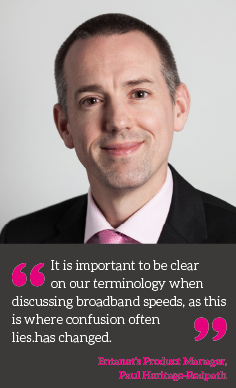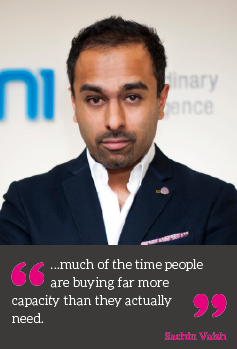
Gigabit broadband has quickly become the goal of fixed broadband providers worldwide. The UK is no exception and from competitive threats to applications not yet thought possible,the drive to deliver gigabit speeds is alive and well.
Faster and faster connectivity at an ever more robust service level is enabling business to deploy applications in the cloud like never before and with the rush about to start on the changeover from ISDN to IP for voice the market is hotting up as we found out when talking to key connectivity suppliers.
Why are we constantly seeking faster access speeds? What’s the application?
Sam Beautridge, Solutions Specialist at True Telecom, says the average business now uses multiple applications that aren’t hosted in their premises.
 “This information is hosted offsite, mostly in the cloud. Most modern day CRMs are all cloud based, as well as HR applications, sales measurement software and increasing demand for hosted voice services, the flexibility and scalability that these solutions offer makes them an increasingly popular choice for growing businesses, this of course leads to a substantial reliance on internet connectivity.
“This information is hosted offsite, mostly in the cloud. Most modern day CRMs are all cloud based, as well as HR applications, sales measurement software and increasing demand for hosted voice services, the flexibility and scalability that these solutions offer makes them an increasingly popular choice for growing businesses, this of course leads to a substantial reliance on internet connectivity.
As a hypothetical example, imagine a company that deals in the installation of car sunroofs. Given the seasonal nature of the business, they will have a huge demand through the summer months and very little through the winter. Historically this business would need to plan and deploy solutions that can meet their upper ends of demand, which focuses on capacity and licenses that will only be utilised for three months of the year.
The cloud and hosted solutions now available would give a business like this the ability to scale system access for when it’s really needed; Need to take extra calls for three months? Fine, take three extra licenses for three months and turn them off after. In order to deliver these types of services, customers need to ensure that they have adequate bandwidth and with cloud applications becoming the norm, SMEs demands and expectations when it comes to their internet connection will only increase.”
Sachin Vaish, Managing Director of Vaioni Wholesale, has seen a huge rise in the demand for what he would term higher speed services – those in excess of 100Mb.
“Clearly some of this has been driven by demand, with key reasons including a significant increase in bandwidth hungry traffic, such as video – in particular video conferencing which is particularly sensitive to time delays. Again it is a case that, with people so used to ‘Skyping’ at home, they expect the same capability in the office as well.
We all know costs and frustrations surrounding slow connectivity speeds or downtime – this continues to be the biggest concern for businesses looking to migrate to the cloud. IT Directors want to ensure that, as they move applications out to the cloud, they have ample connectivity to ensure fast access and guaranteed availability for their applications.
 Of course this is ironic because much of the time people are buying far more capacity than they actually need. In some cases yes, this is just future proofing, but more often than not it is instead of investing in setting their networks up properly and proactively managing their capacity. Deploying the basics such as QoS can help prioritise real time traffic such as voice and video, and at the top end of the market, the industry has also seen substantial development in WAN Optimisation, with some excellent products available from the likes of Silver Peak that can substantially reduce capacity requirements.
Of course this is ironic because much of the time people are buying far more capacity than they actually need. In some cases yes, this is just future proofing, but more often than not it is instead of investing in setting their networks up properly and proactively managing their capacity. Deploying the basics such as QoS can help prioritise real time traffic such as voice and video, and at the top end of the market, the industry has also seen substantial development in WAN Optimisation, with some excellent products available from the likes of Silver Peak that can substantially reduce capacity requirements.
However, the cost of simply buying more capacity is often substantially cheaper – especially in comparison with WAN Optimisation solutions, and not every network provider offers free network monitoring tools, so many SME businesses simply opt for more bandwidth. It’s hard to disagree with their choice.
Gigabit Broadband is, for me, an example of people wanting higher capacity for the sake of it, rather than needing it. Where there is real demand, businesses can get that capacity over fibre, but of course it will cost more.”
What is Superfast today?
George Kinsella, Product Manager, Gamma Data Services defines this within the broadband market as FTTC, which allow for speeds of up to 80Mb down and 20Mb upstream.
“Gamma also take this a stage further and re-engineer FTTC for voice prioritisation and data usage combined, which means businesses can have the call quality they need, without compromise. Looking ahead the introduction of G.Fast from BT will take speeds to 500Mb+, which will comfortably allow for more bandwidth heavy applications such as video - an integral part of most UC deployments.
At the top end of the market, Ethernet speeds of 10 and 100Gb services are due to grow 300% by 2018 however this isn’t being purchased by the SME market where sub 100Mbps speeds are still commonplace and still plenty of bandwidth for most businesses.
We must be careful to separate out superfast speeds from the speed at which faults are resolved which varies significantly between a superfast broadband and a superfast Ethernet service. A business must assess the criticality of each office location by calculating the potential downtime cost of a fault (done using formula N (No x staff) x D (Duration) x I (% Impact) x C (cost/hr).”
Entanet’s Product Manager, Paul Heritage-Redpath, says it is important to be clear on terminology when discussing broadband speeds, as this is where confusion often lies.
“What we are seeing across the market is an abundance of marketing terms being invented as the UK’s major consumer players jostle for position. We’d recommend the channel be clear in their propositions by explaining the technologies in layman’s terms, rather than adopting the more general and often meaningless ‘Infinity’, ‘Superfast’, ‘Ultrafast’ or ‘Gigabit’ terms. That said, we do look forward to the inevitable day when ‘Megafast’ is rolled out!
 ‘Fibre To The Premises’ (FTTP) is the most future-proof and scalable technology to deliver broadband connectivity but its availability is limited. Broadband that delivers ‘gigabit’ speeds is not the goal of Openreach - their goal is quite clearly to sweat their copper assets for as long as possible. Hence, the preferred roll out of FTTC to boost the speed of copper DSL and now G.fast to boost the speed of VDSL as a way of helping them to keep ahead of Virgin’s DOCSIS technology.
‘Fibre To The Premises’ (FTTP) is the most future-proof and scalable technology to deliver broadband connectivity but its availability is limited. Broadband that delivers ‘gigabit’ speeds is not the goal of Openreach - their goal is quite clearly to sweat their copper assets for as long as possible. Hence, the preferred roll out of FTTC to boost the speed of copper DSL and now G.fast to boost the speed of VDSL as a way of helping them to keep ahead of Virgin’s DOCSIS technology.
In a year-long project, TalkTalk are about to deploy FTTP in part of York at speeds of ‘up to 940Mbps’. However, that’s not mathematically a gigabit and those famous little words ‘up to’, which have featured in the on-going battle between Which?, Ofcom, the ASA and industry for so long are still there to muddy the water. So, before the service is even available, its speed is unclear.
We don’t think users spend their days boasting to each other about theoretical speeds. What they want is transparency when they buy and reliability once they’ve bought. Yes, broadband needs to be fast enough to support the increasing number of devices we all use that stream increasing amounts of video and data, but we aren’t seeing a swathe of new applications. After all, we still only have 10 fingers to enter queries and 2 eyes to parse the results!
In our view, asymmetric services of any speed have not kept up with changes in user behaviour with growing adoption of cloud services such as Google Docs, Salesforce, Flikr et al. where content creation is as important as content consumption. For this reason we encourage our channel partners to take advantage of the superior experience offered by uncontended, synchronous Ethernet services wherever customer funds permit, as this will provide a more efficient, stable and reliable service.”
Do you recommend a managed Ethernet service?
“Absolutely” says George Kinsella at Gamma. “With quicker fix times and a more reliable service in general, this needs to be the de facto connectivity choice for businesses who have a huge reliance on their access on a day to day basis – which is most. For smaller businesses where the application is basic web browsing or email to transact business then a fast ADSL or FTTC is sufficient. For larger businesses or businesses using more web based applications which are critical to their success and without which would be to the detriment of their bottom line then Ethernet is essential.
Ever increasing coverage combined with decreasing costs makes Ethernet more affordable than ever and accessible to even the smallest business.”
According to Mark Curtis-Wood at Nimans it is critical for most businesses to have a managed service due to the continued influence of the cloud.
“For many companies the reliance on their internal IT departments won’t be the same moving forward. They need to have a managed service provider they have complete faith and trust in, both now and in the future.
It’s one of the reasons why we have invested in our own Network Operations Centre that enables us to provide a much deeper service to resellers. Managed services used to be about managing a router but for us it’s about enabling resellers to go to their customers and offer pro-active usage information that leads to new higher capacity solutions. This creates new sales opportunities and provides them with the chance to get back in front of their customers and offer a much more proactive and professional service.
What kind of service levels can be offered?
George Kinsella at Gamma, “A robust high quality single SLA can be offered as the sole provider of both services which combined with using a single system ultimately means quicker troubleshooting, being easier to deal with (removes ambiguity of having to call two providers to establish source of fault, update on delivery or billing query) and ultimately a quicker fix time for customers.
At present Gamma offer an enhanced SLA with our assured and converged circuits, a 22 clock hour fix for our broadband services. Beyond that we offer 6-hour fix times for our Ethernet services.”
“Inevitably you get what you pay for,” says Nimans Mark Curtis-Wood, “Copper compared to fibre is a world of difference.
Service levels are so important, get them wrong and they can seriously damage a business. We are talking to resellers a lot more and educating them about thinking about what back up they are putting it. You’ve got to get it right and in most cases DSL isn’t sufficient anymore.”
Brian Iddon at Venus believes the key to an effective network is supplying comprehensive service levels.
“The time to fix service level agreements on the first mile fibre circuits is a must and we deliver this on our 10 gigabit circuits as we do on all our services. We also believe 24/7 operation of technical support is crucial, so our resellers can offer peace of mind when it comes to maintaining networks in a mission critical environment. Our local engineering teams also ensure that provisioning and maintenance teams can get to clients and points of presence quickly and efficiently to provide a top quality service.”
Ed Says…
Interesting observations here - not least of which included Vaioni saying most people pay for more bandwidth than they need. The obvious thing to say on the state of the market is that it is moving very fast – racing to keep up with cloud application demand for example and a picking up of speed on the change out of ISDN to IP networks that will inevitably gain momentum.
There were a couple of terms used in the article that might need explanation:
VDSL: Very High Speed Digital Subscriber Line transmits data in the 13 Mbps - 55 Mbps range over short distances, usually between 300 - 1500 meters, of twisted pair copper wire. The shorter the distance, the faster the connection rate.
DOCSIS: Data Over Cable Service Interface Specification defines interface standards for cable modems and supporting equipment. DOCSIS specifies downstream traffic transfer rates between 27 and 36 Mbps over a radio frequency (RF) path in the 50 MHz to 750+ MHz range, and upstream traffic transfer rates between 320 Kbps and 10 Mbps over a RF path between 5 and 42 MHz. But, because data over cable travels on a shared loop, individuals will see transfer rates drop as more users gain access.
